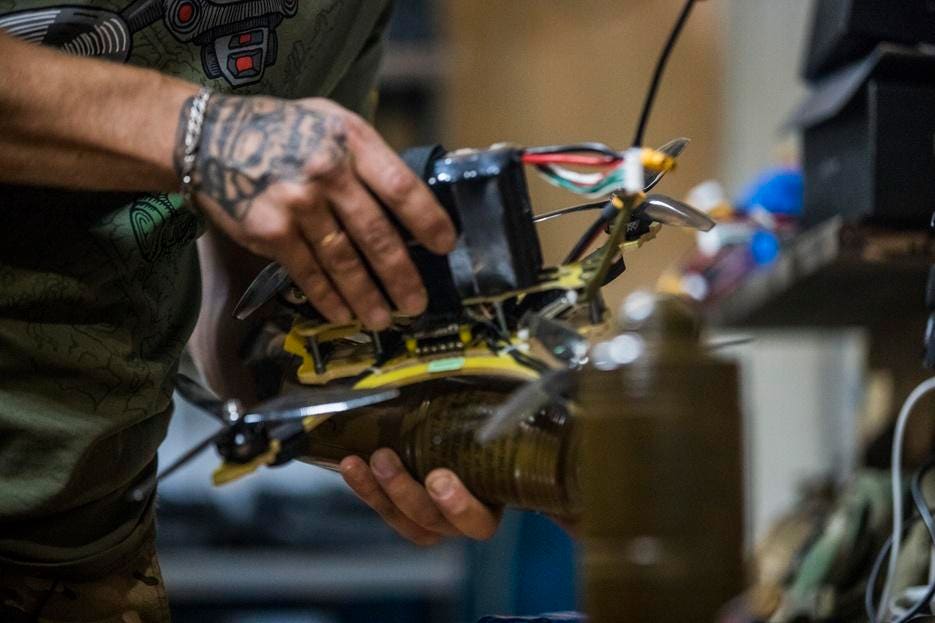New videos shared on social media by the Sudanese Armed Forces show a series of strikes carried out with small FPV kamikaze drones. This type of weapon, first seen just over a year ago in Ukraine, has now become widespread in that conflict, and now looks set to spread worldwide. This is the first time such improvised drones have been seen outside Ukraine, and their appearance in Sudan is a strong indication how easily they will proliferate.
War has been raging in Sudan since April between the Sudanese Armed Forces (SAF) and the paramilitary group known as the Rapid Support Forces (RSF). One compilation video shows a series of FPV attacks against RSF footsoldiers, the other shows multiple strikes against pickup trucks, some of them apparently carrying fighters, attempting to cross a bridge.
In both cases the videos switch between the viewpoint of a drone watching the action from overhead and the pilot’s view from the attack drones, suggesting that the SAF are learning from Ukrainian tactics. FPV stands for First Person View and they fly fast and low, requiring the pilot to wear video goggles and react rapidly to avoid obstacles, and in Ukraine strikes are coordinated by a spotter drone operator directs FPV pilots towards targets and assesses the effects of each strike.
The bridge crossing shows three attacks, two from in front and one from behind, resembling similar Ukrainian strikes on Russian vehicles moving at high speed. The bridge may have been chosen because it gives a clear field of view and a long straight stretch of road with no cover for the attack.
Assembling these drones is straightforward. While some are highly adapted, the simplest are standard racing drones with extra batteries and a warhead attached. Racing quadcopters can fly at speeds of over 100 mph, twice as fast as a typical drone, thanks to their powerful motors. This power means that, at some penalty so speed, they can carry an RPG warhead or similar explosive package weighing a couple of pounds. Volunteer groups in Ukraine and Russia assemble thousands of these drones every month in garages and backrooms from components bought from China at a cost of around $400 each.
FPV drone making is a cottage industry, a matter of low-skilled workers putting together components. One Ukrainian group told the news site UA Position say that with four or five volunteers they put together 15 drones each day. The SAF videos may indicate they have already have a stockpile of FPV drones rather than just a few prototypes from a lone enthusiast, as there are likely to be been several other unsuccessful strikes not included in the edit.
Drones have already featured in Sudan’s civil war. The SAF has a few combat jets, including Chinese aircraft and Russian-made MiG-29s, but has suffered significant losses and their effectiveness is not clear. However, the SAF also operates a fleet of drones, including Ababil and Mohajer types from Iran, some of which carry weapons. The RSF accuse the SAF of carrying out a drone strike on a crowded market in Khartoum which killed more than 40 people earlier this month.
Sudan even has its own military drone industry. Sudan’s Military Industry Corporation (MIC) launched its indigenous Kamin-25 loitering munition at the IDEX 2023 in Abu Dhabi, a fixed-wing design with a 30 mile range and a carrying 15-pound warhead.
On the other side the RSF operates a variety of improvised drones for reconnaissance and attack. In June the SAF shot down an RSF drone which was dropping 120mm mortar bombs, and it seems highly likely that the RSF will also start using FPV
RPV
This is the evolution of warfare in fast forward. Few NATO armies have equivalents to FPV attack drones – the U.S. Switchblade 300 perhaps comes closest – but these are rare and expensive. More importantly, there is no good way to counter them. The best approach is perhaps radio-frequency jamming, but widespread use by both side in Ukraine has not stemmed the tide of FPV attacks. As the Sudanese videos show, an FPV drone operator can hit a fast-moving target with high precision from several miles away. They can dive into trenches or through windows, making most cover useless, and they can take out armored vehicles including tanks.
If kamikaze FPVs are already turning up in a backwater like Sudan, the chances are that even the least sophisticated combatants will have them in every other combat zone in the near future. This should be a wake up call for military planners in the U.S. and elsewhere.
Read the full article here





